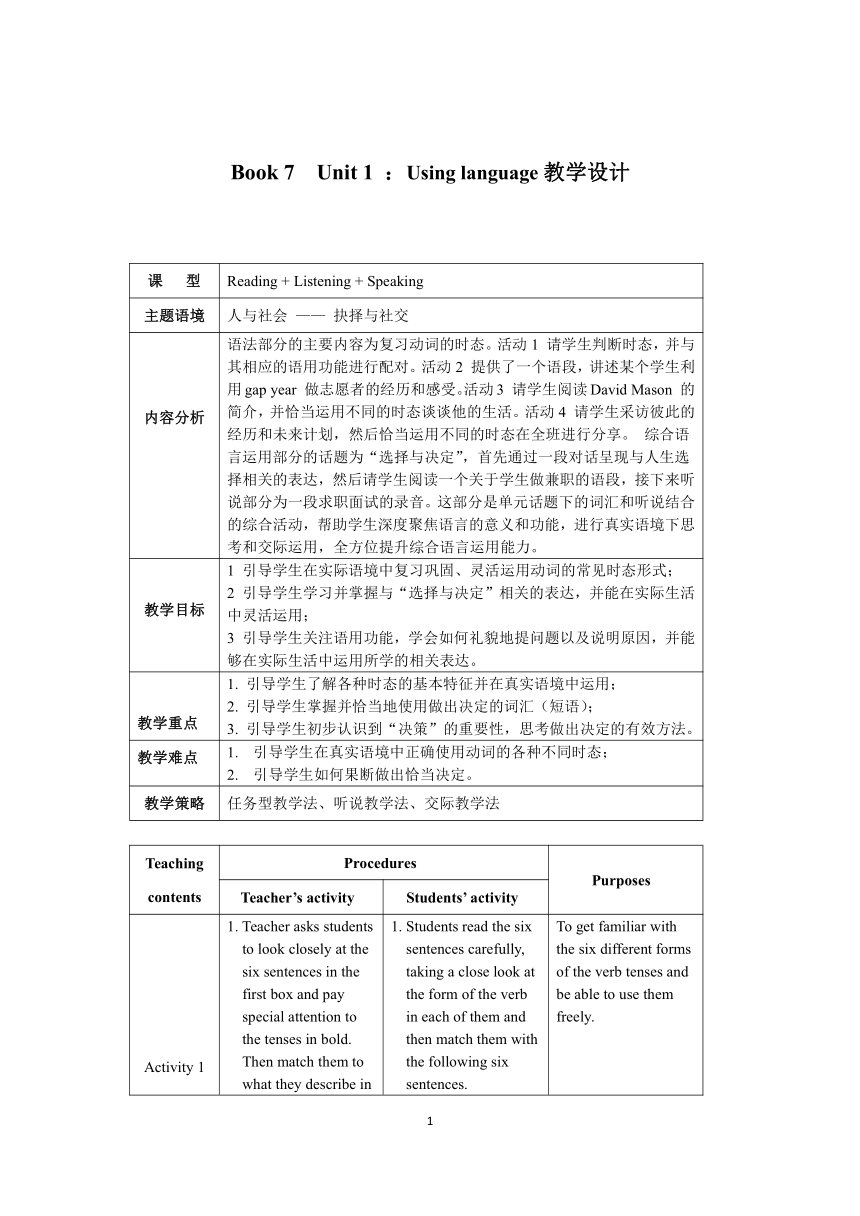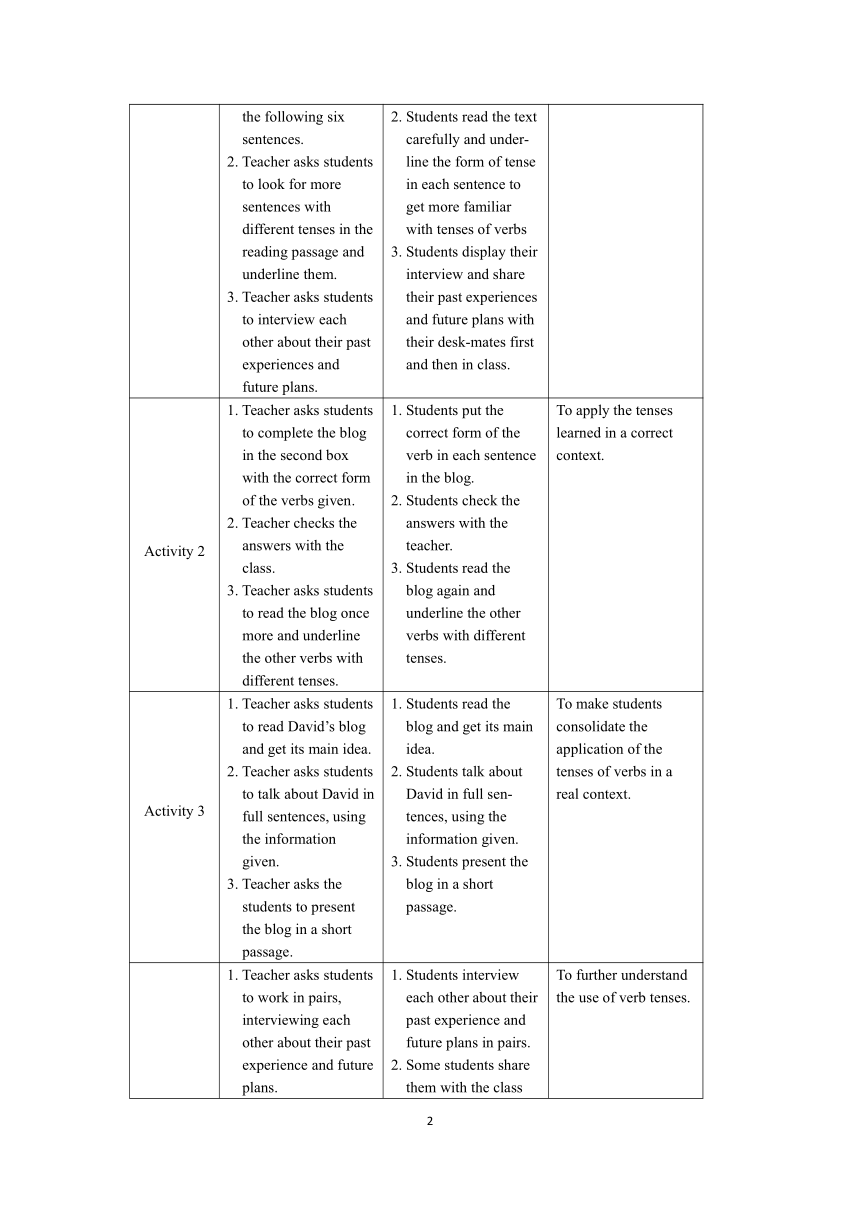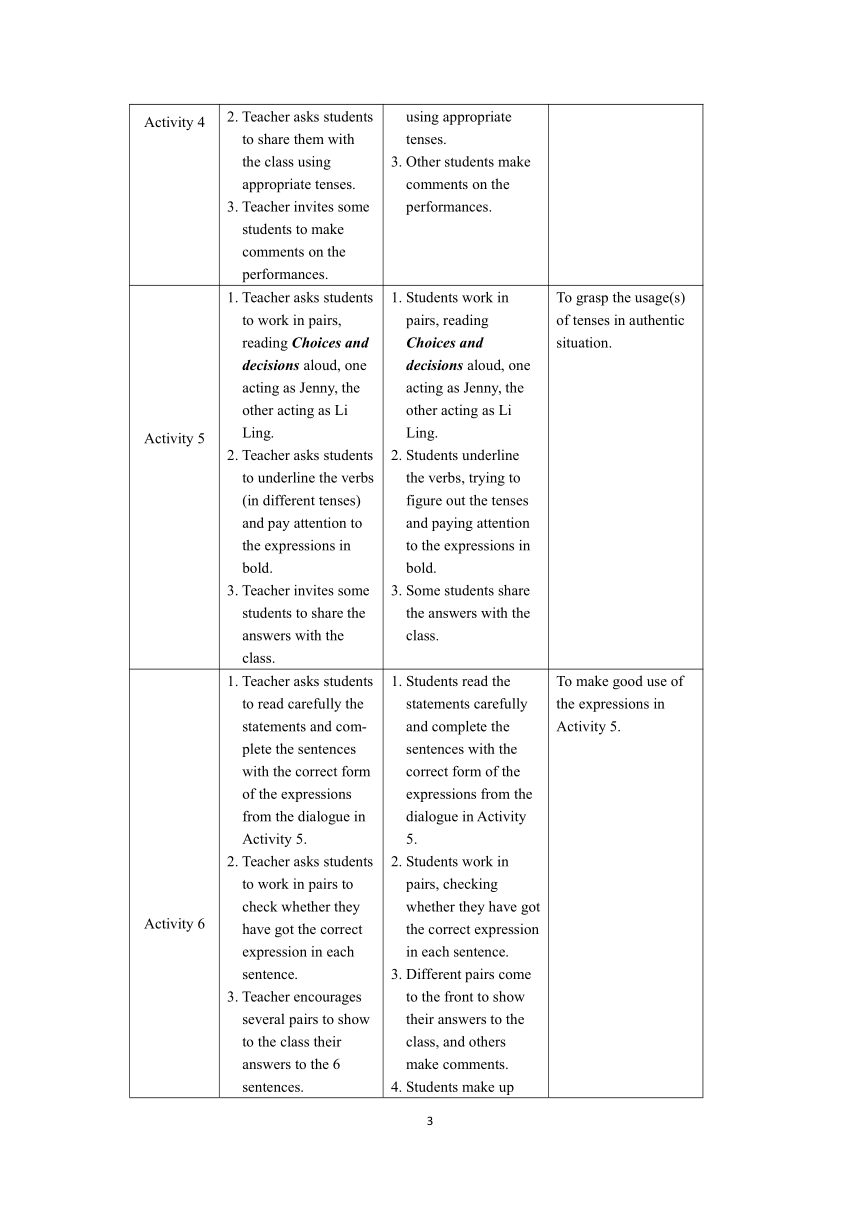外研版(2019)选择性必修 第四册Unit 1 Looking forwards Using language教学设计(表格式)
文档属性
| 名称 | 外研版(2019)选择性必修 第四册Unit 1 Looking forwards Using language教学设计(表格式) |  | |
| 格式 | docx | ||
| 文件大小 | 28.8KB | ||
| 资源类型 | 教案 | ||
| 版本资源 | 外研版(2019) | ||
| 科目 | 英语 | ||
| 更新时间 | 2025-07-08 21:27:06 | ||
图片预览



文档简介
Book 7 Unit 1 :Using language教学设计
课 型 Reading + Listening + Speaking
主题语境 人与社会 —— 抉择与社交
内容分析 语法部分的主要内容为复习动词的时态。活动1 请学生判断时态,并与其相应的语用功能进行配对。活动2 提供了一个语段,讲述某个学生利用gap year 做志愿者的经历和感受。活动3 请学生阅读David Mason 的简介,并恰当运用不同的时态谈谈他的生活。活动4 请学生采访彼此的经历和未来计划,然后恰当运用不同的时态在全班进行分享。 综合语言运用部分的话题为“选择与决定”,首先通过一段对话呈现与人生选择相关的表达,然后请学生阅读一个关于学生做兼职的语段,接下来听说部分为一段求职面试的录音。这部分是单元话题下的词汇和听说结合的综合活动,帮助学生深度聚焦语言的意义和功能,进行真实语境下思考和交际运用,全方位提升综合语言运用能力。
教学目标 1 引导学生在实际语境中复习巩固、灵活运用动词的常见时态形式; 2 引导学生学习并掌握与“选择与决定”相关的表达,并能在实际生活 中灵活运用; 3 引导学生关注语用功能,学会如何礼貌地提问题以及说明原因,并能 够在实际生活中运用所学的相关表达。
教学重点 1. 引导学生了解各种时态的基本特征并在真实语境中运用; 2. 引导学生掌握并恰当地使用做出决定的词汇(短语); 3. 引导学生初步认识到“决策”的重要性,思考做出决定的有效方法。
教学难点 引导学生在真实语境中正确使用动词的各种不同时态; 引导学生如何果断做出恰当决定。
教学策略 任务型教学法、听说教学法、交际教学法
Teaching contents Procedures Purposes
Teacher’s activity Students’ activity
Activity 1 1. Teacher asks students to look closely at the six sentences in the first box and pay special attention to the tenses in bold. Then match them to what they describe in the following six sentences. 2. Teacher asks students to look for more sentences with different tenses in the reading passage and underline them. 3. Teacher asks students to interview each other about their past experiences and future plans. 1. Students read the six sentences carefully, taking a close look at the form of the verb in each of them and then match them with the following six sentences. 2. Students read the text carefully and under- line the form of tense in each sentence to get more familiar with tenses of verbs 3. Students display their interview and share their past experiences and future plans with their desk-mates first and then in class. To get familiar with the six different forms of the verb tenses and be able to use them freely.
Activity 2 1. Teacher asks students to complete the blog in the second box with the correct form of the verbs given. 2. Teacher checks the answers with the class. 3. Teacher asks students to read the blog once more and underline the other verbs with different tenses. 1. Students put the correct form of the verb in each sentence in the blog. 2. Students check the answers with the teacher. 3. Students read the blog again and underline the other verbs with different tenses. To apply the tenses learned in a correct context.
Activity 3 1. Teacher asks students to read David’s blog and get its main idea. 2. Teacher asks students to talk about David in full sentences, using the information given. 3. Teacher asks the students to present the blog in a short passage. 1. Students read the blog and get its main idea. 2. Students talk about David in full sen- tences, using the information given. 3. Students present the blog in a short passage. To make students consolidate the application of the tenses of verbs in a real context.
Activity 4 1. Teacher asks students to work in pairs, interviewing each other about their past experience and future plans. 2. Teacher asks students to share them with the class using appropriate tenses. 3. Teacher invites some students to make comments on the performances. 1. Students interview each other about their past experience and future plans in pairs. 2. Some students share them with the class using appropriate tenses. 3. Other students make comments on the performances. To further understand the use of verb tenses.
Activity 5 1. Teacher asks students to work in pairs, reading Choices and decisions aloud, one acting as Jenny, the other acting as Li Ling. 2. Teacher asks students to underline the verbs (in different tenses) and pay attention to the expressions in bold. 3. Teacher invites some students to share the answers with the class. 1. Students work in pairs, reading Choices and decisions aloud, one acting as Jenny, the other acting as Li Ling. 2. Students underline the verbs, trying to figure out the tenses and paying attention to the expressions in bold. 3. Some students share the answers with the class. To grasp the usage(s) of tenses in authentic situation.
Activity 6 1. Teacher asks students to read carefully the statements and com- plete the sentences with the correct form of the expressions from the dialogue in Activity 5. 2. Teacher asks students to work in pairs to check whether they have got the correct expression in each sentence. 3. Teacher encourages several pairs to show to the class their answers to the 6 sentences. 4. Teacher asks students to make up sentences of their own, using the expressions in the conversation between Jenny and Li Ming. 1. Students read the statements carefully and complete the sentences with the correct form of the expressions from the dialogue in Activity 5. 2. Students work in pairs, checking whether they have got the correct expression in each sentence. 3. Different pairs come to the front to show their answers to the class, and others make comments. 4. Students make up their own sentences with the expressions learned in Activity 5 so as to consolidate these expressions. To make good use of the expressions in Activity 5.
Activity 7 1. Teacher asks students to read the passage at least twice. 2. Teacher has students work in pairs to do “ask-and-answer” of the 3 questions below the passage 3. Teacher checks the answer with the class. 1. Students read the passage once more. 2. Students do “ask-and- answer” of the 3 questions below the passage in pairs. 3. Students check the answer with the teacher. To train the skills of grasping the main content of a reading passage.
Activity 8 1. Teacher asks students to read carefully the four advertisements first and try to be familiar with them. 2. Teacher plays the audio for students and has them get as much information as possible, asking students to choose the job and checks the answers in pairs. 3. Teacher asks some students to give the performance in class. 1. Students carefully read first the four advertisements and try to be familiar with them. 2. Students do pair work, listening to the audio carefully and try to get as much information as possible and checking the answers with their desk-mate. 3. Students give the performance in class. 1. To understand the details of the listening material 2. To learn the ways to choose a job.
Activity 9 1. Teacher asks students to listen once more to the interview to get ready to complete the notes. 2. Teacher asks students to fill in the ten blanks. 3. Teacher asks students to work in pairs and ask and answer the 4 “Why… ” questions. 4. Teacher asks students to work in pairs again to decide whether Richard should get the job or not, and give their reasons. 1. Students listen once more to the interview to get ready to complete the notes. 2. Students try to fill in the ten blanks individually. 3. Students work in pairs: one asks the questions and the other answers them, and then change the roles. 4. Students work again in pairs to decide whether Richard should get the job or not and give reasons. To develop students ability to ask and answer questions introduced by “why”.
Activity 10 1. Teacher divides students into two groups and asks them to complete the boxes with the expressions from the interview. 2. Teacher has Group Ⅰ ask questions one by one while Group Ⅱ answer them. 3. Teacher asks students to change the role: Group Ⅱ ask questions one by one while Group Ⅰ answer them. 1. Students work in group and complete the boxes with the two different expressions. 2. Group I ask questions One by one while Group Ⅱ answer them. 3. Students change the role: Group Ⅱ ask questions one by one while Group Ⅰ answer them. To further practise giving suggestions.
Activity 11 1. Teacher asks students to work in pairs and choose a part-time job advertisement in Activity 8 and get ready for the present- ation of the job interview, trying to use the expressions in this section. 2. Teacher asks pairs of students to the front to give presentation. 3. Teacher asks students to evaluate the presentations according to how effectively they participate in the job interview. 1. Students work in pairs and choose a part-time job advertisement in Activity 8 and get ready for the present- ation of the job interview, trying to use the expressions in this section. 2. Pairs of students are invited to the front to give presentation, and others make comments. 3. Students evaluate the presentations according to how effectively those pairs participate in the job interview. To check how effectively students could participate in a job interview.
6
课 型 Reading + Listening + Speaking
主题语境 人与社会 —— 抉择与社交
内容分析 语法部分的主要内容为复习动词的时态。活动1 请学生判断时态,并与其相应的语用功能进行配对。活动2 提供了一个语段,讲述某个学生利用gap year 做志愿者的经历和感受。活动3 请学生阅读David Mason 的简介,并恰当运用不同的时态谈谈他的生活。活动4 请学生采访彼此的经历和未来计划,然后恰当运用不同的时态在全班进行分享。 综合语言运用部分的话题为“选择与决定”,首先通过一段对话呈现与人生选择相关的表达,然后请学生阅读一个关于学生做兼职的语段,接下来听说部分为一段求职面试的录音。这部分是单元话题下的词汇和听说结合的综合活动,帮助学生深度聚焦语言的意义和功能,进行真实语境下思考和交际运用,全方位提升综合语言运用能力。
教学目标 1 引导学生在实际语境中复习巩固、灵活运用动词的常见时态形式; 2 引导学生学习并掌握与“选择与决定”相关的表达,并能在实际生活 中灵活运用; 3 引导学生关注语用功能,学会如何礼貌地提问题以及说明原因,并能 够在实际生活中运用所学的相关表达。
教学重点 1. 引导学生了解各种时态的基本特征并在真实语境中运用; 2. 引导学生掌握并恰当地使用做出决定的词汇(短语); 3. 引导学生初步认识到“决策”的重要性,思考做出决定的有效方法。
教学难点 引导学生在真实语境中正确使用动词的各种不同时态; 引导学生如何果断做出恰当决定。
教学策略 任务型教学法、听说教学法、交际教学法
Teaching contents Procedures Purposes
Teacher’s activity Students’ activity
Activity 1 1. Teacher asks students to look closely at the six sentences in the first box and pay special attention to the tenses in bold. Then match them to what they describe in the following six sentences. 2. Teacher asks students to look for more sentences with different tenses in the reading passage and underline them. 3. Teacher asks students to interview each other about their past experiences and future plans. 1. Students read the six sentences carefully, taking a close look at the form of the verb in each of them and then match them with the following six sentences. 2. Students read the text carefully and under- line the form of tense in each sentence to get more familiar with tenses of verbs 3. Students display their interview and share their past experiences and future plans with their desk-mates first and then in class. To get familiar with the six different forms of the verb tenses and be able to use them freely.
Activity 2 1. Teacher asks students to complete the blog in the second box with the correct form of the verbs given. 2. Teacher checks the answers with the class. 3. Teacher asks students to read the blog once more and underline the other verbs with different tenses. 1. Students put the correct form of the verb in each sentence in the blog. 2. Students check the answers with the teacher. 3. Students read the blog again and underline the other verbs with different tenses. To apply the tenses learned in a correct context.
Activity 3 1. Teacher asks students to read David’s blog and get its main idea. 2. Teacher asks students to talk about David in full sentences, using the information given. 3. Teacher asks the students to present the blog in a short passage. 1. Students read the blog and get its main idea. 2. Students talk about David in full sen- tences, using the information given. 3. Students present the blog in a short passage. To make students consolidate the application of the tenses of verbs in a real context.
Activity 4 1. Teacher asks students to work in pairs, interviewing each other about their past experience and future plans. 2. Teacher asks students to share them with the class using appropriate tenses. 3. Teacher invites some students to make comments on the performances. 1. Students interview each other about their past experience and future plans in pairs. 2. Some students share them with the class using appropriate tenses. 3. Other students make comments on the performances. To further understand the use of verb tenses.
Activity 5 1. Teacher asks students to work in pairs, reading Choices and decisions aloud, one acting as Jenny, the other acting as Li Ling. 2. Teacher asks students to underline the verbs (in different tenses) and pay attention to the expressions in bold. 3. Teacher invites some students to share the answers with the class. 1. Students work in pairs, reading Choices and decisions aloud, one acting as Jenny, the other acting as Li Ling. 2. Students underline the verbs, trying to figure out the tenses and paying attention to the expressions in bold. 3. Some students share the answers with the class. To grasp the usage(s) of tenses in authentic situation.
Activity 6 1. Teacher asks students to read carefully the statements and com- plete the sentences with the correct form of the expressions from the dialogue in Activity 5. 2. Teacher asks students to work in pairs to check whether they have got the correct expression in each sentence. 3. Teacher encourages several pairs to show to the class their answers to the 6 sentences. 4. Teacher asks students to make up sentences of their own, using the expressions in the conversation between Jenny and Li Ming. 1. Students read the statements carefully and complete the sentences with the correct form of the expressions from the dialogue in Activity 5. 2. Students work in pairs, checking whether they have got the correct expression in each sentence. 3. Different pairs come to the front to show their answers to the class, and others make comments. 4. Students make up their own sentences with the expressions learned in Activity 5 so as to consolidate these expressions. To make good use of the expressions in Activity 5.
Activity 7 1. Teacher asks students to read the passage at least twice. 2. Teacher has students work in pairs to do “ask-and-answer” of the 3 questions below the passage 3. Teacher checks the answer with the class. 1. Students read the passage once more. 2. Students do “ask-and- answer” of the 3 questions below the passage in pairs. 3. Students check the answer with the teacher. To train the skills of grasping the main content of a reading passage.
Activity 8 1. Teacher asks students to read carefully the four advertisements first and try to be familiar with them. 2. Teacher plays the audio for students and has them get as much information as possible, asking students to choose the job and checks the answers in pairs. 3. Teacher asks some students to give the performance in class. 1. Students carefully read first the four advertisements and try to be familiar with them. 2. Students do pair work, listening to the audio carefully and try to get as much information as possible and checking the answers with their desk-mate. 3. Students give the performance in class. 1. To understand the details of the listening material 2. To learn the ways to choose a job.
Activity 9 1. Teacher asks students to listen once more to the interview to get ready to complete the notes. 2. Teacher asks students to fill in the ten blanks. 3. Teacher asks students to work in pairs and ask and answer the 4 “Why… ” questions. 4. Teacher asks students to work in pairs again to decide whether Richard should get the job or not, and give their reasons. 1. Students listen once more to the interview to get ready to complete the notes. 2. Students try to fill in the ten blanks individually. 3. Students work in pairs: one asks the questions and the other answers them, and then change the roles. 4. Students work again in pairs to decide whether Richard should get the job or not and give reasons. To develop students ability to ask and answer questions introduced by “why”.
Activity 10 1. Teacher divides students into two groups and asks them to complete the boxes with the expressions from the interview. 2. Teacher has Group Ⅰ ask questions one by one while Group Ⅱ answer them. 3. Teacher asks students to change the role: Group Ⅱ ask questions one by one while Group Ⅰ answer them. 1. Students work in group and complete the boxes with the two different expressions. 2. Group I ask questions One by one while Group Ⅱ answer them. 3. Students change the role: Group Ⅱ ask questions one by one while Group Ⅰ answer them. To further practise giving suggestions.
Activity 11 1. Teacher asks students to work in pairs and choose a part-time job advertisement in Activity 8 and get ready for the present- ation of the job interview, trying to use the expressions in this section. 2. Teacher asks pairs of students to the front to give presentation. 3. Teacher asks students to evaluate the presentations according to how effectively they participate in the job interview. 1. Students work in pairs and choose a part-time job advertisement in Activity 8 and get ready for the present- ation of the job interview, trying to use the expressions in this section. 2. Pairs of students are invited to the front to give presentation, and others make comments. 3. Students evaluate the presentations according to how effectively those pairs participate in the job interview. To check how effectively students could participate in a job interview.
6
